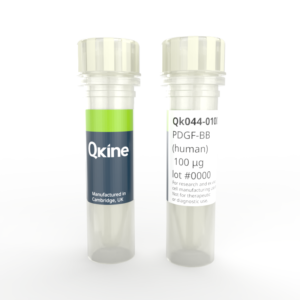 Recombinant human PDGF-BB protein (Qk044)
Recombinant human PDGF-BB protein (Qk044)Recombinant human PDGF-BB protein (Qk044)
Price range: £230.00 through £2,900.00
Human PDGF-BB (platelet derived growth factor BB) protein is a homodimer of PDGF-B peptide chains. Its is a potent mitogen expressed by platelets which stimulates proliferation and angiogenesis and is involved in tissue repair. PDGF-BB increases stem cell proliferation and marker expression and can be used in osteogenic and neural stem cell differentiation.
Qkine recombinant human PDGF-BB is a highly pure 25 kDa disulfide–linked bioactive dimeric protein, animal origin-free (AOF), tag free and carrier protein-free.
In stock
Orders are typically shipped same or next day (except Friday).
Easy world-wide ordering, direct or through our distributors.
Price range: £230.00 through £2,900.00
Fast and free shipping.
Buy online with secure credit card or purchase order. For any questions, please email orders@qkine.com
Summary:
- High purity human PDGF-BB protein (Uniprot: P01127)
- 25 kDa
>98%, by SDS-PAGE quantitative densitometry
Expressed in E. coli
Animal origin-free (AOF) and carrier protein-free
Manufactured in our Cambridge, UK laboratories
Lyophilized from acetonitrile, TFA
- Resuspend in sterile-filtered water at >50 µg/ml, add carrier protein if desired, prepare single use aliquots and store frozen at -20 °C (short-term) or -80 °C (long-term).
Featured applications:
Neural stem cell proliferation and neuronal differentiation
Expansion of induced pluripotent, embryonic and mesenchymal stem cells
Osteogenic differentiation

PDGF-BB activity was measured using a NFAT-responsive luciferase assay in HEK293 cells co-transfected with PDGFBR. Cells were treated in triplicate with a serial dilution of PDGF-BB for 6 hours. Firefly luciferase activity was measured and readings were normalised to the maximum response. Data from Qk044 lot #204627. EC50 = 12.7 ng/ml (0.52 nM).
PDGF-BB migrates as a single band at ~30 kDa in non-reducing (NR) conditions and 13 kDa upon reduction (R). No contaminating protein bands are visible. Purified recombinant protein (3 µg) was resolved using 15% w/v SDS-PAGE in reduced (+β-mercaptothanol, R) and non-reduced (NR) conditions and stained with Coomassie Brilliant Blue R250. Data from Qk044 batch #104306.

Further quality assays
Mass spectrometry: single species with expected mass
Recovery from stock vial: >95%
Endotoxin: <0.005 EU/μg protein (below level of detection)
We are a company founded and run by scientists to provide a service and support innovation in stem cell biology and regenerative medicine. All our products are exceptionally high purity, with complete characterisation and bioactivity analysis on every lot.

Qkine PDGF-BB is more biologically active than a comparable alternative supplier protein. Quantitative luciferase assay with Qkine PDGF-BB (Qk044, green) and alternative supplier PDGF-BB (Supplier B, black). Cells were treated in triplicate with a serial dilution of PDGF-BB for 6 hours. Firefly luciferase activity was measured and normalized to control Renilla luciferase activity.
Technote | PDGF-BB (Qk044) bioactivityProtein background
Platelet derived growth factor (PDGF) is part of the PDGF family. As the name suggests it is produced by platelets, and by several other cell types including endothelial cells, fibroblasts, vascular smooth muscle cells, osteoblasts, glia and neurons [1]. In platelets, PDGF is stored in α-granules, and released in response to platelet activation, leading to stimulation of epithelial cells. PDGF is a potent mitogen for cells of mesenchymal origin such as fibroblasts, glial cells and vascular smooth muscle cells.
PDGFs are dimers of PDGF-A, -B, -C or -D polypeptide chains, arranged in homodimers (e.g. PDGF-AA and PDGF-BB) or heterodimers (e.g. PDGF-AB). There are two receptors for PDGFs, PDGFR-α and PDGFR-β. PDGFR-α is a receptor for all PDGF dimers apart from PDGF-DD, while PDGFR-β is a receptor for PDGF-BB and PDGF-DD [2]. Activation of these receptors by PDGF leads to activation of downstream signalling pathways including PI3K, MAPK and STAT3 pathways [3]. PDGF plays an important role in embryonic development [4], cell proliferation, cell migration and angiogenesis. PDGF is a potent mitogen for cells of mesenchymal origin such as fibroblasts, glial cells and vascular smooth muscle cells.
PDGF-BB promotes stem cell proliferation and stem cell marker expression, it can promote migration of stem cells, such as mesenchymal stem cells (MSCs) and increases cell viability in stem cell spheroids from human bone marrow-derived stem cells [5]. PDGF-BB acts as a neurotrophic factor and is involved in the proliferation and differentiation of neuronal progenitor cells [6]. It can be used in the neuronal differentiation of urine-derived stem cells (USCs) where it stimulates the trans-differentiation of USC into neuronal cells [6]. Clinically, PDGF-BB can be used in the treatment of periodontal and orthopedic bone defects and dermal wound healing [7].
Additional resources
Publications using Recombinant human PDGF-BB protein (Qk044)
-
Pervanadate-induced oxidation relieves autoinhibition of SRC protein tyrosine kinase
Mulholland KE, Bourguet M, Cheng N et al.
DOI: doi.org/10.1101/2025.04.27.650842
Our products are for research use only and not for diagnostic or therapeutic use. Products are not for resale.

Receive an Amazon gift voucher when you leave us a review.
£25, $30 or €30 for reviews with an image and £10, $15 or €15 for reviews without an image
